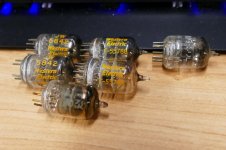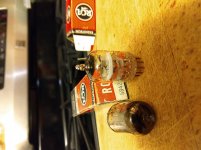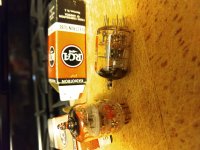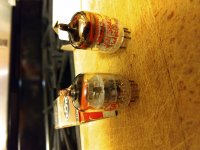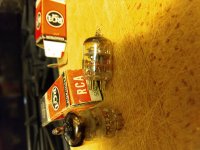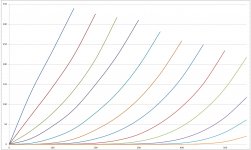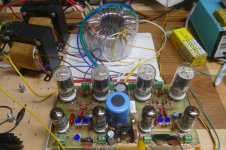6S3P-EV ?
Not a big fan of Russia... but it might be our only available and affordable replacement option.
6S3P-EV / EC86 / PC86 triode tubes Lot of 100 NOS WE417A | eBay
6S3P-EV / WE417A / EC86 tube - PREAMP / DRIVER tubes - Tubes-Store.com
6S3P = EC86 = PC86 tube. High-frequency triode ― Hi-End vacuum tubes, sockets, capacitors, nixie. Retail and wholesale to worldwide.
Not a big fan of Russia... but it might be our only available and affordable replacement option.
6S3P-EV / EC86 / PC86 triode tubes Lot of 100 NOS WE417A | eBay
6S3P-EV / WE417A / EC86 tube - PREAMP / DRIVER tubes - Tubes-Store.com
6S3P = EC86 = PC86 tube. High-frequency triode ― Hi-End vacuum tubes, sockets, capacitors, nixie. Retail and wholesale to worldwide.
I bought a pair of WE 417A's a few years back
I sold all but 3 of mine last year.
6S3P-EV ?
One of these vendors uses a name that's similar to a popular US based tube store. They also label these as if they were exact replacements which they are NOT!
6S3P-EV / WE417 / EC86 tube
The 6S3P is NOT pin compatible with the WE417 or the EC86
It's vendors like this, and those who sell junk used tubes as new, that convinced me that direct tube purchases from Russia or the Ukraine weren't worth it.
I opened a random tube caddy here at the office that I knew had some 5842's in it, and found one 1963 date code tube, five 1965 date code tubes, and two 1970 date code tubes, all Raytheon, NOS in boxes. So 5842 had a long production run, likely in pretty big batches. And I am sure I have seen Raytheons with date codes in the late 1980's, may have some at home, or in the warehouse of junk.
I find it tough to believe that 5842 is in any type of tight supply; audiophile status brings high prices. If normal supply and demand prevailed, it would probably still be a $5 - $10 tube.
Did anyone make 5842 besides Raytheon? I would think there would have to be a second source of supply, but I don't think I have ever seen a non Raytheon 5842, other than those dual marked RCA's.
Win W5JAG
I find it tough to believe that 5842 is in any type of tight supply; audiophile status brings high prices. If normal supply and demand prevailed, it would probably still be a $5 - $10 tube.
Did anyone make 5842 besides Raytheon? I would think there would have to be a second source of supply, but I don't think I have ever seen a non Raytheon 5842, other than those dual marked RCA's.
Win W5JAG
I had the previously mentioned Ericssons, and some WE417A's were dual marked 417A/5842.
Since my last post I discovered a few more tubes hiding in my stash. There are some Western Electric tubes marked JW 5842 in the usual yellow paint, no mention of 417A. There are also some WE tubes marked only F-55788. One has no getter left. I plugged the other F-55788 into the TSE-II and it works.
I now have two TungSol tubes, and they were not likely made by Raytheon. The getter has no stamped steel support, it is "D" shaped and not connected to anything internally.
I have another oddball that has faint white lettering, gold pins and the number "039" etched vertically along one side. It is a different construction from all the others. No clue who made it, or what brand it was. The printing is too messed up.
Since my last post I discovered a few more tubes hiding in my stash. There are some Western Electric tubes marked JW 5842 in the usual yellow paint, no mention of 417A. There are also some WE tubes marked only F-55788. One has no getter left. I plugged the other F-55788 into the TSE-II and it works.
I now have two TungSol tubes, and they were not likely made by Raytheon. The getter has no stamped steel support, it is "D" shaped and not connected to anything internally.
I have another oddball that has faint white lettering, gold pins and the number "039" etched vertically along one side. It is a different construction from all the others. No clue who made it, or what brand it was. The printing is too messed up.
Attachments
Technically the 417A has a Mu of 43 or 44 while the 5842 is 50. I have compared WE417A's to Raytheon 5842's and they are indeed different. The WE417A does have lower gain and they make it hard to drive a 300B to clipping from an iPHONE source. Yes, people use WE tubes in a TSE with a phone, iPOD or iPAD source, so I must test for that.
More gain can be obtained by increasing the value of R15 and R26 to 470K or 1 meg. This change will be incorporated in the new parts list for the TSE-II.
I have not yet directly compared the different flavors of WE tubes, and I sold most of my collection to fund further activities of Tubelab.
I discovered this bag of tubes yesterday while looking for something else. They were segregated for a reason over 10 years ago, but I don't remember why. They may have problems, but I will try them all when I have time....right now it's tax time.
More gain can be obtained by increasing the value of R15 and R26 to 470K or 1 meg. This change will be incorporated in the new parts list for the TSE-II.
I have not yet directly compared the different flavors of WE tubes, and I sold most of my collection to fund further activities of Tubelab.
I discovered this bag of tubes yesterday while looking for something else. They were segregated for a reason over 10 years ago, but I don't remember why. They may have problems, but I will try them all when I have time....right now it's tax time.
... another oddball that has ... gold pins ...
My dual marked RCA's have gold pins, and I am thinking they are actually Amperex. That oddball might be an Amperex, but all I have here at the office are Raytheons. The RCA whatevers are at home, so I can't get a pic of them.
I've never seen a Raytheon marked as anything other than a 5842. But I have the dual marked RCA's, that might be a 5842. Or they might be a 417A?
I had them in a modded TSE, but don't recall them being any different in gain from a Raytheon. But I have tons of drive, the TSE board was hacked for 801A's at the time, or maybe the SV811-10's which wouldn't need much drive, and I didn't look for this characteristic, so really can't say one way or the other. I think I paid $ 8 each for the RCA's; about the going rate for 5842's at the time.
What really piqued my curiosity was that Tube Depot picture of the high $$ WE tube that is plainly marked 5842 and clearly looks to be a genuine WE tube. And now George has pics of WE 5842. But WE made 417A, not 5842. Or so I thought.
Win W5JAG
Another interesting pic
5842, Tube 5842; Rohre 5842 ID5904, Triode, vacuum
Shows a WE marked JW5842, but you can see 417A at the bottom.
Randy
5842, Tube 5842; Rohre 5842 ID5904, Triode, vacuum
Shows a WE marked JW5842, but you can see 417A at the bottom.
Randy
GEC CV3789 / 417A
| TubeDepot.com
Pic of GEC 417A with gold pins.
I'll try to dig out my RCA's and get a pic later this afternoon / evening when I get home. Can't find anything but Raytheons here at the office.
Win W5JAG
| TubeDepot.com
Pic of GEC 417A with gold pins.
I'll try to dig out my RCA's and get a pic later this afternoon / evening when I get home. Can't find anything but Raytheons here at the office.
Win W5JAG
Shows a WE marked JW5842, but you can see 417A at the bottom.....and some WE417A's were dual marked 417A/5842.
That's pretty common. Many of the tubes I sold were marked like that, so was the Mu 43, 43, or 50....or maybe somewhere in between. I imagine that it wouldn't make much difference in the RF circuits that these tubes were intended for.
The TSE loads the tube with a CCS, so the only AC load on the tube is R15 or R26 and the Crss of the mosfets. I am testing some new mosfets that run around 1 pF and have raised the resistor to 1 meg. That gets me a gain of about 40 with a Raytheon 5842. I haven't played the tube rolling game yet, but I will when I catch up on everything else.
Two date codes - 1962 and 1966. Clearly marked made in USA, but have the cross seams on the top of the glass, and what looks like Mullard codes etched into the glass. They also have larger digits etched into the glass, similar to Tubelab's mystery tube, but that didn't show up well in the pics.
The Raytheon is a 1985 date code. I found some 1984, also.
I'm still thinking Amperex. But are they 5842's, or 417A's?
Win W5JAG
The Raytheon is a 1985 date code. I found some 1984, also.
I'm still thinking Amperex. But are they 5842's, or 417A's?
Win W5JAG
Attachments
Last edited:
Plus is they are cheap. Minus might be the 7 pin socket
7 pin tubes do seem to be scorned even though there are sockets available.
The minus that you can't see is how many are available. I have access to the inventory list at a popular tube seller, and I can call another to see how many they have. There are less then 200 6AN4's in stock at the place I can check via computer.
Another possible choice is the 6J4. At least there are over 1000 of them in stock. Granted this does not always reflect the availability of the tube in question at other tube retailers, but it's a resource I use when checking into a tube design.
There is another possibility on paper. I don't actually have any yet, so I'm not going to mention it's number.
Twice I have gone down the road for a tube design only to have someone buy up ALL of the available tubes leaving me with a design, sometimes a PCB, and zero tubes for it. There were 7,000 6HB6's in stock until someone mentioned them here, then poof, all gone, to a Hong Kong buyer. Ditto the 13GB5, over 20,000 tubes have been sucked up by a single US customer. Both were on the dollar lists at two popular tube sellers.
I have a new amp design that's the little brother to the 100 WPC 13GB5 amp. This time I was the customer that bought 500 of each tube to hedge my bet before getting a stack of PC board that are useless.
Maybe this is blasphemy, but how about using a pentode in the input stage? Something like the EF86 should give you more gain than you can shake a stick at. Likely high enough that you could wrap a little feedback around it to stabilize the gain and lower gain variation from tube to tube. Just a thought...
Tom
Tom
but how about using a pentode in the input stage?
I have several pentode driving pentode amps in the works. Two are working prototypes now. The unique thing is the triode curves I'm tricking those pentodes into giving me. The curves ARE evenly spaced. My manual measurements with Harbor Freight measurements are a bit off in the placement of the 4th line.
This "un-triode" is a TV sweep tube that looks like a triode, and eats 550 volts. A pair of them will squeeze out 80 WPC on a regulated supply, and 50 WPC on an Antek toroid. All 8 tubes are pentodes.
The amp shown here is a push pull design. Meet Little Brother from post #97. There is a Single Ended un-triode I call the UN-SET in the works.
Attachments
Last edited:
I'm still thinking Amperex. But are they 5842's, or 417A's?
Win W5JAG
In the third picture you can see the code "VK4".
VK is the Philips code for 5842.
The first symbol of the code under the VK4 should identify the factory.
- Home
- More Vendors...
- Tubelab
- After a 14 year run, the TSE must DIE!
